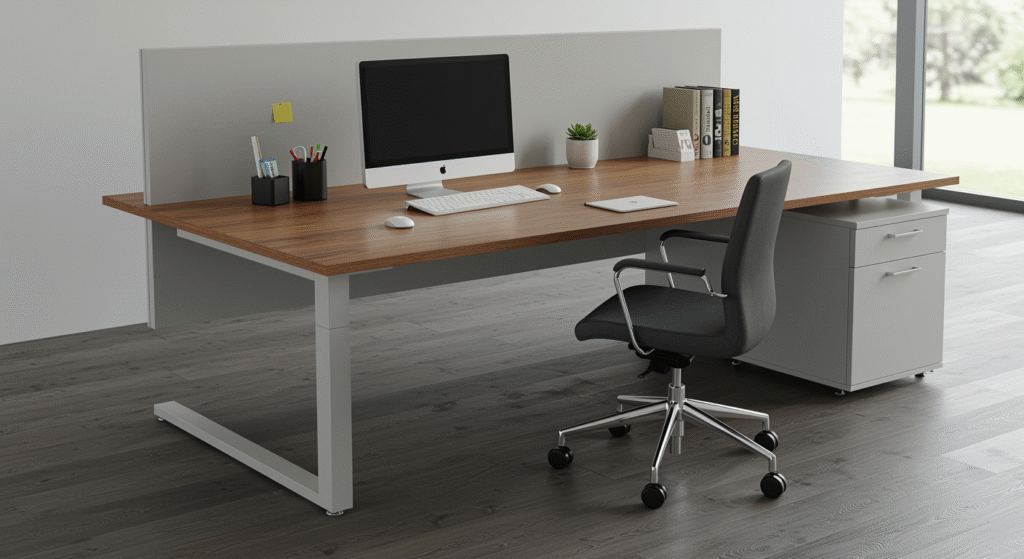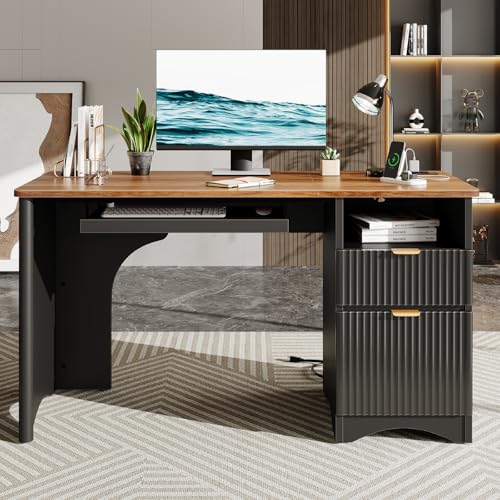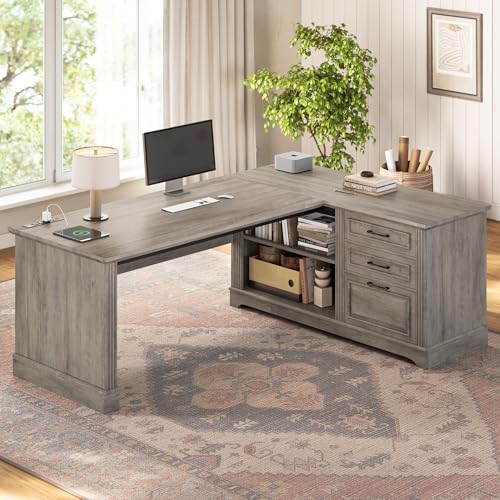
In 2025, the office desk is no longer simply a utilitarian piece of furniture; it is a sophisticated element of holistic workspace design. Design professionals today face the challenge and opportunity to create desks that support health, incorporate cutting-edge technology, and embrace sustainable materials, all while designing for aesthetic appeal and adaptability. The office desk has evolved into a dynamic, smart workstation that reflects the changing nature of work itself—hybrid, digital, and user-centric. This comprehensive guide presents an in-depth look at the crucial aspects shaping modern office desks for the design professional.
- ALL-IN-ONE OFFICE DESK: Coming with a storage cabinet, file drawer, and storage shelves, this executive desk create a ve…
- LARGE WORKING SPACE: This larger office desk offers a spacious work area with a 63” L large desktop and 31.5″ W width th…
- SOLID CONSTRUCTION: This solid constructed computer desk is made from E0-grade board and rugged metal frame, which is st…
Key Design Principles for Office Desks
One of the foundational pillars guiding modern office desk design is ergonomics. Long hours at a desk demand furniture that supports healthy posture and minimizes strain. Adjustable sit-stand desks have become industry staples, allowing users to alternate between sitting and standing to reduce musculoskeletal stress and improve circulation. For a design professional, incorporating height adjustment mechanisms that are both robust and smoothly operable is critical. Motorized options with quiet operation are favored in professional environments.
Material selection also plays a significant role. Sustainable materials are no longer niche but expected in office furniture to meet corporate social responsibility goals and consumer preferences. Bamboo, for instance, offers a fast-growing, renewable option that is both durable and visually warm. High-density laminates and recycled composites provide surface durability and resistance to wear while minimizing environmental impact. Understanding the characteristics and lifecycle impact of these materials can guide procurement specifications for clients.
Clean, minimalistic design language often dominates contemporary office furniture aesthetics. Cable management systems integrated into the desk frame prevent clutter and maintain the sleek, professional appearance required in executive and creative spaces alike. Desks with concealed compartments for chargers and peripherals enhance user satisfaction by organizing digital tools efficiently.
Integrating Technology in Office Desk Design
The rapid digitalization of workspaces has transformed desks into connectivity hubs. Design professionals must consider the full digital ecosystem surrounding the user. Embedded USB-C and power outlets ensure users can readily plug in multiple devices. Wireless charging pads embedded in desktop surfaces eliminate cable tangles and meet the needs of increasingly wireless workplaces.
More advanced desks now incorporate IoT technology to promote wellness and productivity. Sensors track sitting duration and posture, providing actionable data through companion apps that remind users to adjust their position or take breaks. Environmental sensors monitor light, temperature, and humidity, feeding real-time data that allow users or building systems to optimize comfort. Such features represent a fusion of ergonomics, technology, and behavioral science, contributing to healthier workplaces.
Compatibility with smart office management systems is an emerging requirement. Desks that interface with workplace software can be booked, customized, or monitored remotely, supporting hybrid and flexible work arrangements where desk sharing and hot-desking are common.
Spatial Strategy and Accessibility Considerations
The best-designed desks are those that integrate smoothly into the broader office environment. Design professionals must analyze spatial flow to place desks where natural light optimizes visibility and energy. Acoustic considerations include materials that reduce noise reflected from desk surfaces or under-desk storage units that absorb sound.
Modular and configurable desk systems enable flexible office layouts that can adapt to changing needs—from collaborative zones requiring bench-style desks to individual focus areas where privacy panels and noise dampening may be necessary. Considering human factors, adjustable desks must also accommodate users of different heights, sizes, and abilities, ensuring inclusive design. Surface height ranges and clear legroom compliant with ADA standards are essential.
The rise in hybrid work means many office desks must also be suitable for home use. Compact footprint desks with multi-functional surfaces serve this need and allow design professionals to cater to a range of client types and spaces.
Future Trends in Office Desk Design
Looking beyond current standards, the future office desk is anticipated to be even more multifunctional and connected. Modularity will be paramount, with components designed for easy swapping or upgrading, reducing waste and extending product lifespan. This aligns with circular economy principles gaining momentum in the furniture industry.
Advanced lighting solutions integrated within desks will adjust based on circadian rhythms, boosting worker alertness or relaxation as needed through dynamic color temperature and intensity changes. AI-driven ergonomic coaching, delivered via desk interfaces or connected apps, will personalize health recommendations, promoting sustained user wellbeing.
Sustainability will deepen as a priority: designers and manufacturers will explore entirely biodegradable materials, energy-harvesting surfaces, and smart use of recycled content to meet global climate goals.
Case Study: Ergonomic Office Desk Market in 2025
The global market for ergonomic office desks has rapidly expanded, fueled by hybrid work adoption. Recent studies show a compound annual growth rate (CAGR) of approximately 18% from 2022 to 2026. Design professionals benefit from analyzing consumer preferences that increasingly favor desks with sit-stand capability, modular designs, and tech integration.
Brands focusing on durable construction with sustainable materials and comprehensive warranty offerings retain higher customer loyalty. Clients often seek full-service solutions, providing assembly, customization, and integration support, emphasizing the importance of design professionals offering holistic solutions.
Review: Smart Office Desk Technologies
Market leaders in smart desks include features such as wireless charging stations seamlessly embedded in desktop surfaces, multiport USB and power hubs, and sensor-driven posture correction reminders. Many units offer app-based control panels enabling personalized height presets and schedule-based adjustments. RGB ambient lighting integrated into desk perimeters creates mood-enhancing work conditions, adjustable through mobile applications.
However, challenges remain in ensuring interoperability between different smart office systems and maintaining cybersecurity for IoT-connected desks. Design professionals should work closely with IT and facilities management to ensure seamless and secure integration.
Frequently Asked Questions About Office Desks
Q1: What materials are best for modern office desks?
A: Sustainable woods like bamboo, recycled composites, and high-density laminates offer durability and environmental benefits. Metals with powder-coated finishes are ideal for structural frames due to strength and longevity.
Q2: How does an adjustable sit-stand desk benefit users?
A: It promotes healthier posture through movement variation, reduces risks of chronic pain, improves circulation, and enhances cognitive function by preventing fatigue.
Q3: What technology features should a smart office desk include?
A: Wireless charging, integrated power outlets and USB hubs, IoT posture and environment sensors, app-based height and lighting adjustments. Future designs may add AI coaching and health monitoring.
Q4: How can office desks support workplace inclusivity?
A: By offering adjustable heights with wide range, wheelchair-accessible clearances, intuitive controls, and accommodating diverse body sizes and abilities in the design.
Q5: How does modular design benefit office desk use?
A: Modular components allow flexible configuration, easy replacement or upgrade of parts, reducing waste and enabling customization to various spatial and functional requirements.
Conclusion
For design professionals, the office desk is far more than a workstation; it is a complex interface between user, technology, and environment. In 2025, desks must harmonize ergonomics, integrated digital tools, sustainable materials, and inclusive design to meet evolving workplace demands. Future-ready desks foster productivity, wellness, and adaptability in increasingly fluid work environments. By leveraging innovation and interdisciplinary collaboration, design professionals can create office desks that are not only functional aesthetics but pivotal in shaping the future of work.




